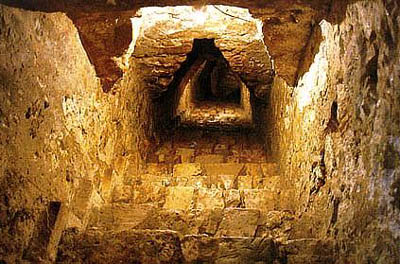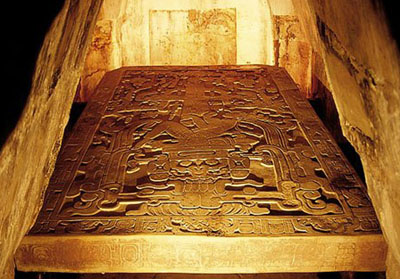
The phenomenal Maya city of Palenque lies in the primeval forest
of Chiapas.

The Palace, also known as the "University", majestically
extends over the area. Old narrations
of the Hopi Indians recount about the city of Palatkwapi that was
built by the Katchinas.
It was constructed as a multi-storey pyramid for the customers of
the stars, the growing of nature,
the medicinal plants and for the historyof the three worlds.

As in most ruins around the world, only
15% of Palenque's area
has been researched and made free from the primeval forest.

The archeologist Alberto Ruz Lhuillier first discovered the burial
chamber of Pacal under
the "Temple of Inscriptions" in 1952. The most impressive
Maya relief was found here,
the "Brass of Palenque". The pyramid's name as well as
the descriptions of the remaing buildings
were given by archeologists because there are no existing written
or oral narrations thanks to the
work of the spanish conquerors in South America. They destroyed
everyting, including the primitives,
in the name of God! Amen. It is no wonder that today people stand
impressed in front of the ruins,
and there is no plausible explanation for the unbelievable
knowledge that the Maya had about
planetary orbits and constellations.

A steep staircase leads down to the foundations
of the pyramid...

...then it is so
far!

The burial chamber under the Temple of Inscriptions.
The brass of Palenque can be admired behind plexiglass nowadays.
Huge stalactites hung
from the ceiling during the discovery. This means that the chamber
is very old.
The brass measures 3.8m by 2.2m,
has a depth of 25cm, and weighs
many tons. It covers a huge sarcophagus. The chamber lies a few
meters under the
pyramid's foundations. The pyramid was therefore built over the
grave.

Many
archeologists gave wild meanings to the Relief.
From revenge of the earth monster to the life journey to the god
of death,
from the god of wheat Yum Kox to the beardy weather god. Anything
that a blooming fantasy
comes up with was suggested. But an interpration baffles and irritates
the experts.
Erich von Däniken saw a man sitting in a flying object on the
brass, just like during the start of a shuttle!

And even newer explanations, like in the "World of the Maya"
programme,
without thinking of the consequences of their claims, reported on
"the ruler Pacal that traveled from the underworld to our world!!!"
Very interesting... but with what he traveled in still needs to
be explained!
The hieroglyphs and partly decyphered, and are proof of clear relationships
between the planets and the Milky Way (Zak Beh), the home of their
gods.
The oldest date on the relief dates back to 3000 BC.

The exterior form of the "vehicle" has a similarity to
the
Stupas in Borobodur (Central Java).
Even in these images one could
journey to the gods, as described in the original doctrine of the
Buddhists.
Ritual movements and acts had to be additionaly executed.












